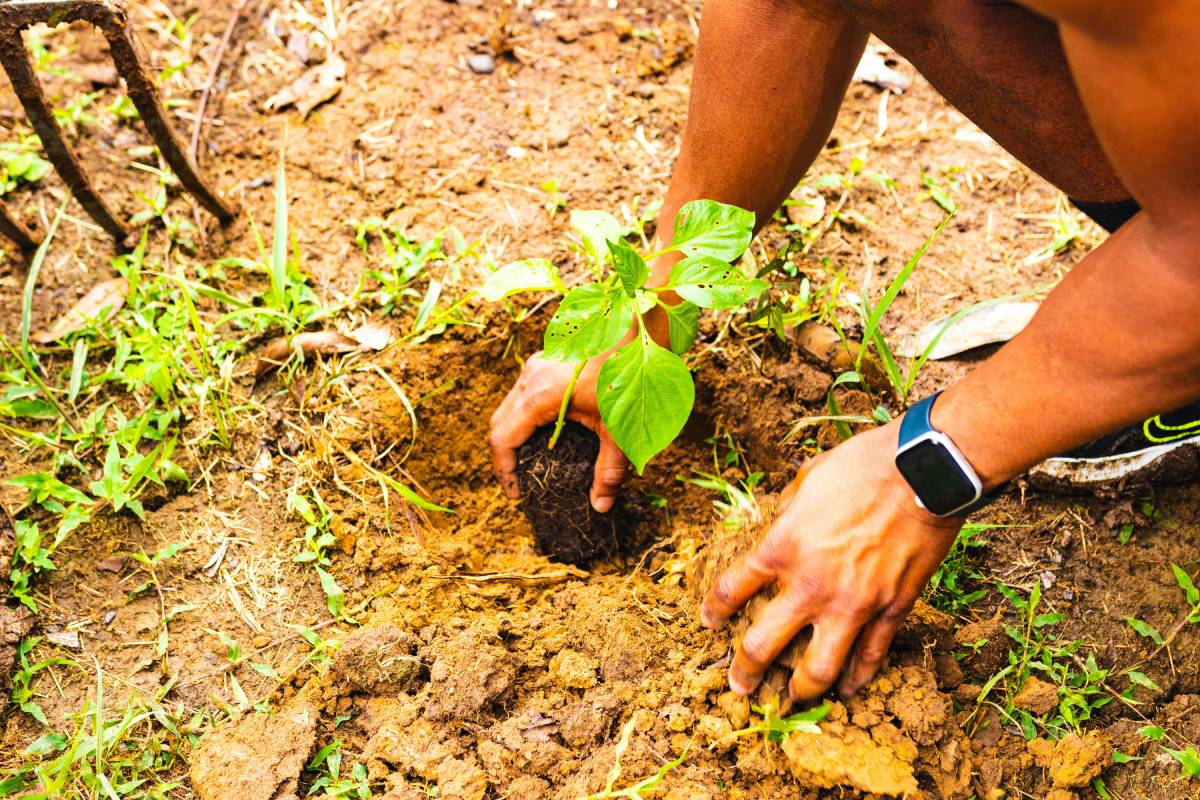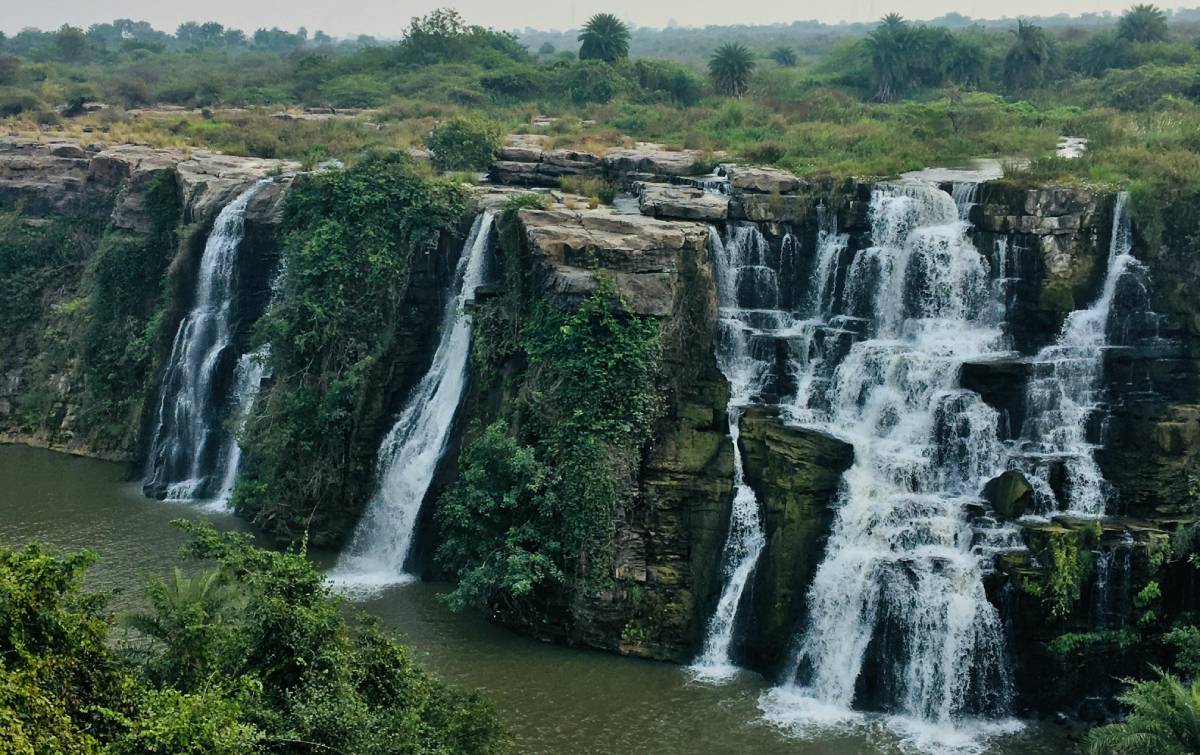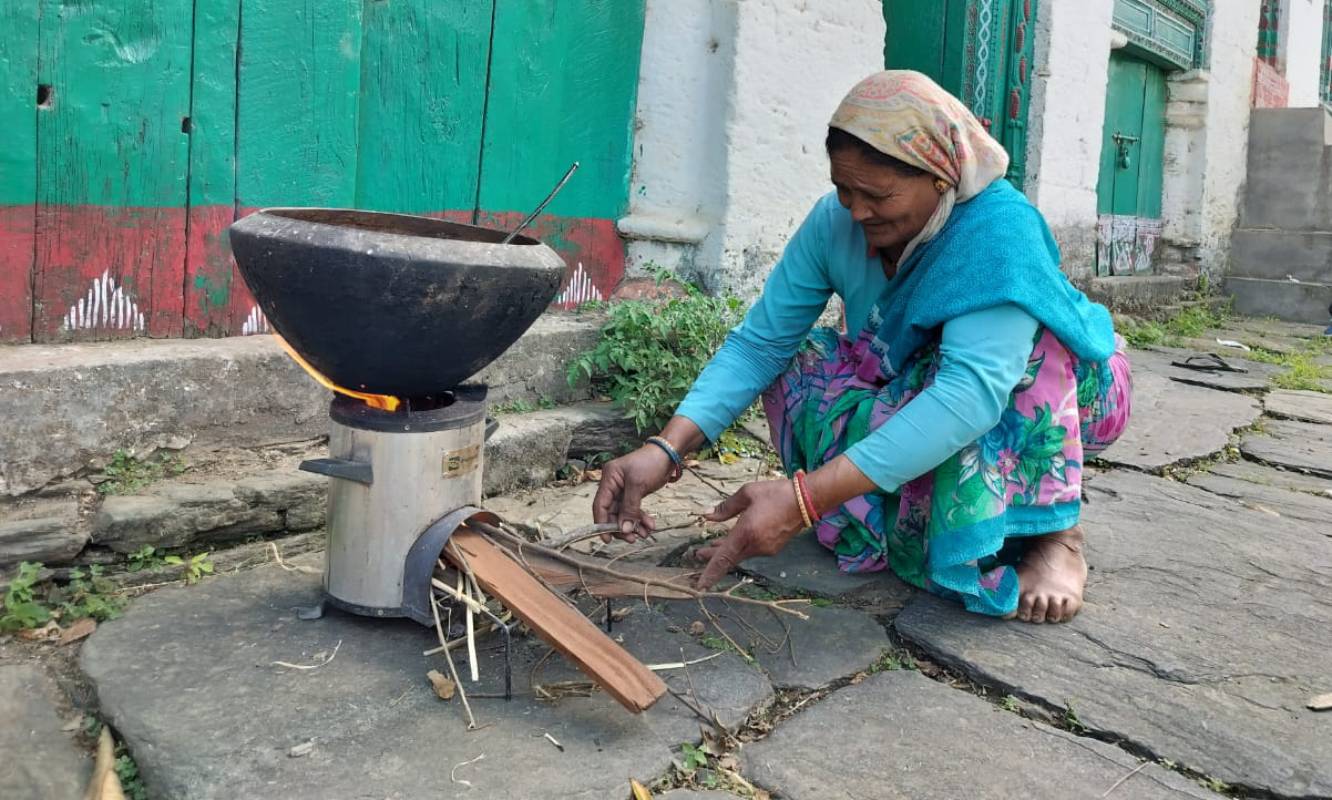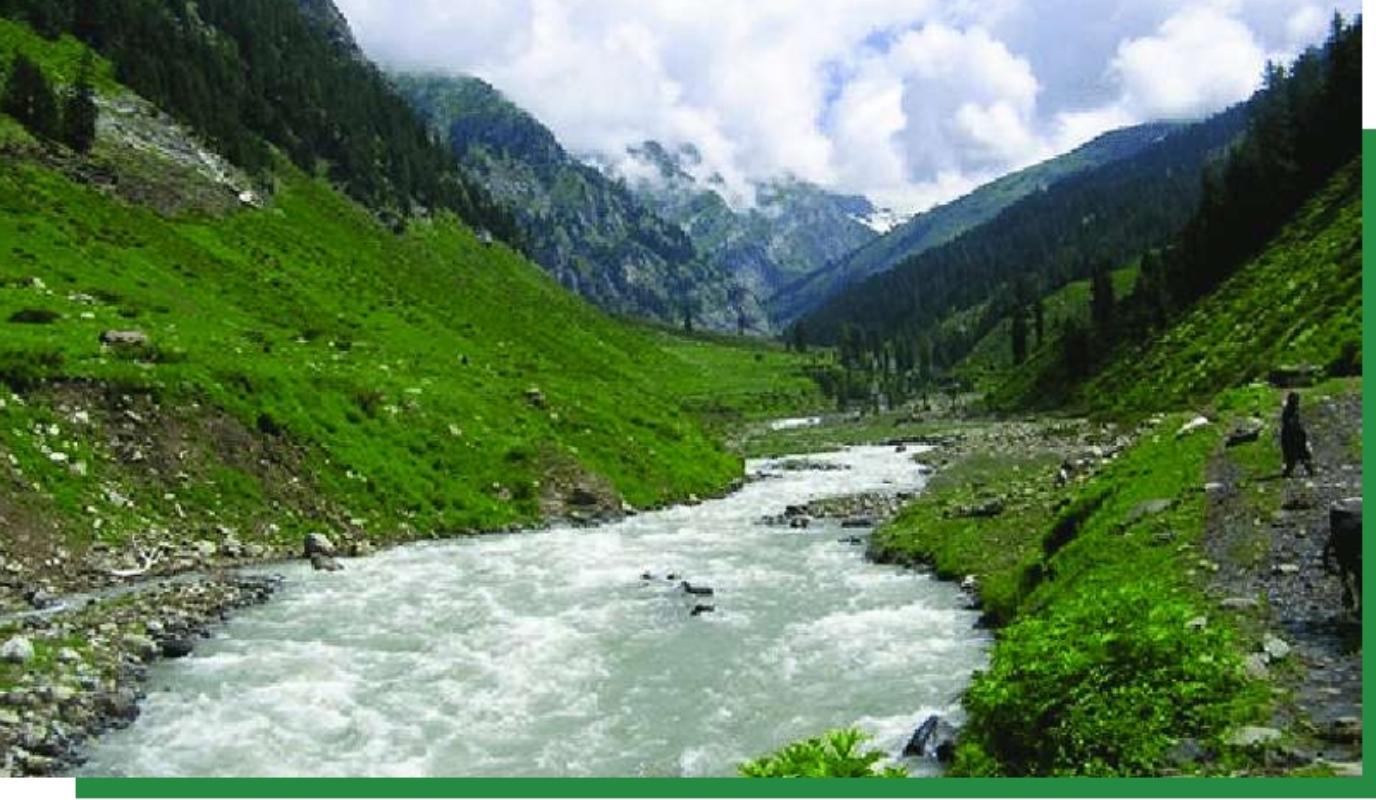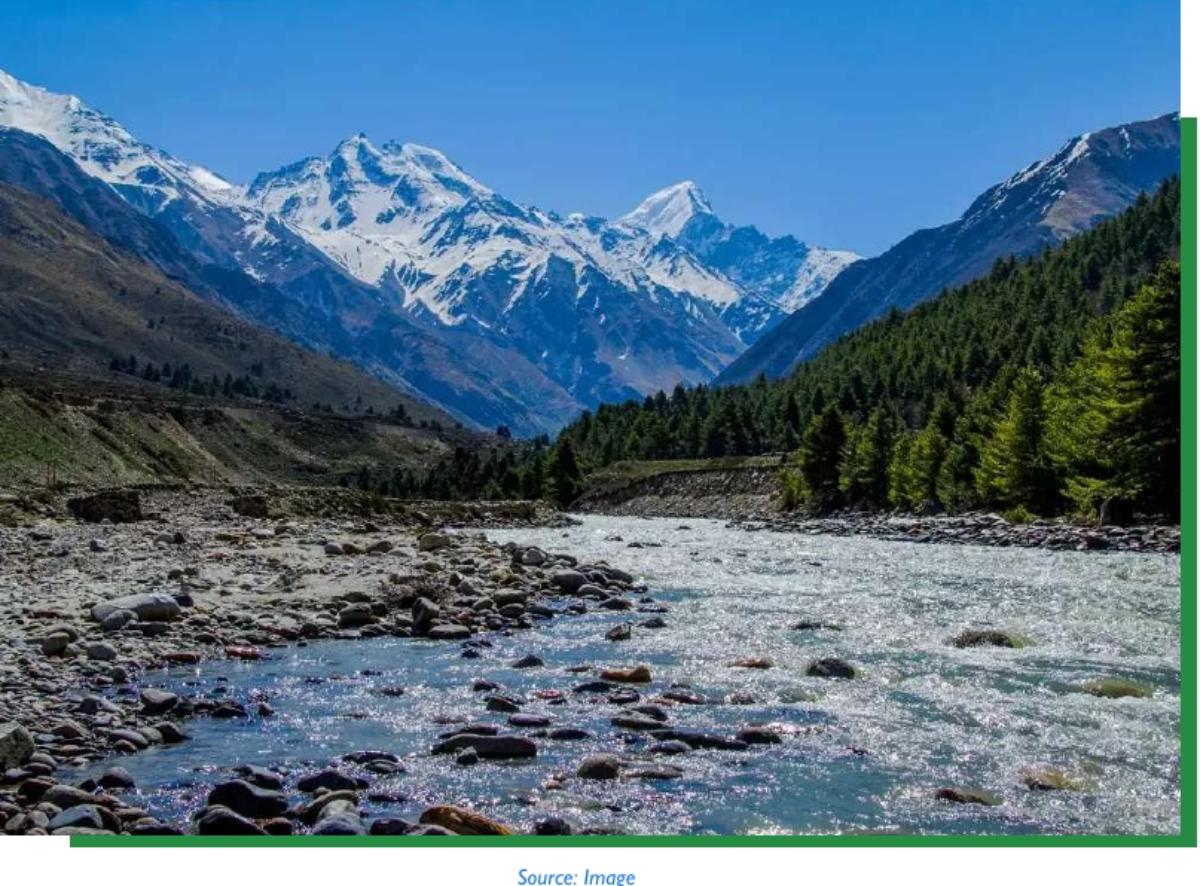Soils are home to an estimated 25% of the world’s biodiversity and merely a teaspoon of healthy soil contains about one billion microorganisms. This richness of the oils is the foundation of life on the earth. Apart from agriculture the top soil is valuable for many other purposes such as construction materials, grasslands and forests. The erosion of topsoil and soil contamination leads to decline in productivity of land in terms of biodiversity. The soil degradation is caused by various factors including adverse climatic conditions and human induced factors such as chemical farming, pollution and deforestation. According to Navdanya Foundation, “industrial chemical agriculture has destroyed soil fertility; depleted the water holding capacity of soil; destroyed the biodiversity that provides food and nutritional security and protects the soil and contributed to 40% of the GreenHouse Gases that are causing climate change.[1]”
Arresting rapid erosion of soil is highly crucial for countries like India which is second most populous country and second largest producer of food and agriculture. Most people in India are still dependent on agriculture and livestock for their lives and livelihood. Healthy soil is not only important for producing healthy food but also to combat adverse impacts of climate change. The blend of high population, high agricultural production and diverse agro-climatic conditions creates more pressure on land which results in rise in risks related to land degradation.
According to a latest survey by Space Application Centre, Ahmedabad, 97.85 million hectare of India’s landmass which accounts for 29.77% of the total geographical area of the country is under degradation and desertification. Compared to the survey conducted in 2003-04 the land under degradation has increased from 94.53 mha to 97.85 mha.
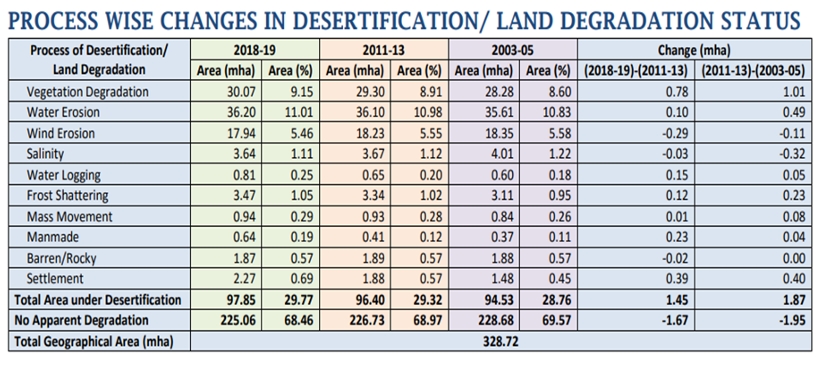
Source: https://vedas.sac.gov.in/static/atlas/dsm/DLD_Atlas_SAC_2021.pdf
Land degradation and desertification in India is majorly caused by vegetation degradation, water erosion and wind erosion. These three factors together contribute to the degradation of more than 84 mha land mass of the country. Other than the above estimate of land degradation, there have been several other estimates using different methodologies to calculate land degradation in India.
Assessment of land degradation in India by different agencies/organizations
| Agencies/Organizations | Year | Area (million hectares) |
| National Commission on Agriculture | 1976 | 148.09 |
| Ministry of Agriculture (Soil and Water Conservation Division) | 1978 | 175.00 |
| National Remote Sensing Agency (NRSA) | 1985 | 53.28 |
| Ministry of Agriculture | 1985 | 173.64 |
| Ministry of Agriculture | 1994 | 107.43 |
| ICAR-National Bureau of Soil Survey and Land Use Planning (NBSS&LUP) | 1994 | 187.70 |
| ICAR-NBSS&LUP (Revised) | 2004 | 146.82 |
| Indian Council of Agricultural Research, National Academy of Agricultural Sciences (NAAS) based on harmonized database | 2010 | 120.70 |
| Space Applications Centre (SAC), Indian Space Research Organization (ISRO), Ahmedabad (based on Indian Remote Sensing Satellite (IRS) Advanced Wide Field Sensor (AWiFS) data | 2016 | 96.40 |
| Department of Land Resources in collaboration with the National Remote Sensing Centre (Wastelands Atlas of India) | 2019 | 55.77 |
Source: https://pib.gov.in/PressReleasePage.aspx?PRID=1810912
The first official assessment on land degradation was conducted in 1977 by the National Commission on Agriculture. It estimated that 148.09 mha of landmass was under degradation. Several other agencies have since then assessed land under degradation. These assessments are way different from one another because of the different methodology and technology adopted by each agency. The assessment conducted by National Academy of Agricultural Science (NAAS) in 2010 estimated cultivable land under soil erosion. As per this estimate 92.4 mha cultivable land in India is threatened by soil erosion.
Soil Health and Agricultural Production:
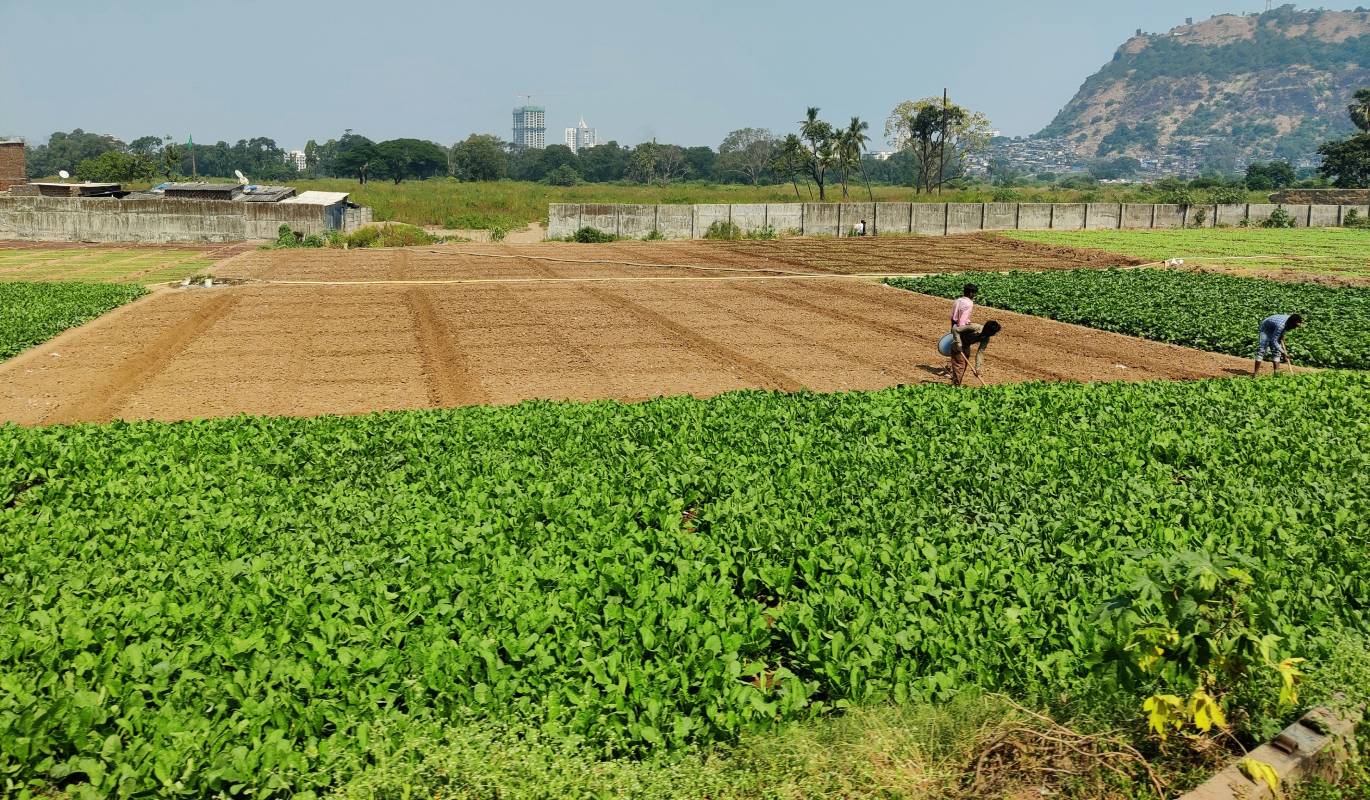
The top most layer of earth’s crust is known as soil and it is formed due to several physical, organic and chemical processes. The soil is an important terrestrial resource like water, which is largely neglected. The good health of soil is not only important for the high value crop production but also important for sustenance of ecosystem services. Humans worldwide obtain more than 99.7% of their food from the soil. Further the ever deterioration of soil health across the globe has reduced the productivity of all natural ecosystems such as agriculture, water availability, forest and pasture ecosystems. The reduced productivity of ecosystems has also affected the nutrition level of human beings. According to an estimate today around 66% of the world population is malnourished[2]. Therefore, for the wellbeing of human, wildlife and various other ecosystems keeping good health of soil is important.
The term soil health refers to properties of soil and critical function of the soil. J.W Doran and his colleagues in 1996 defined soil health as “the continued capacity of soil to function as a vital living system within ecosystem and land-use boundaries, to sustain biological productivity, maintain the quality of air and water environments, and promote plant, animal and human health.” Major functions of soils related to agriculture are infiltration and storage of water, retention and cycling of nutrients, pest and weeds suppression, detoxification of harmful chemicals, carbon sequestration and production of food and fibre[3].
Extent of Soil Erosion in India
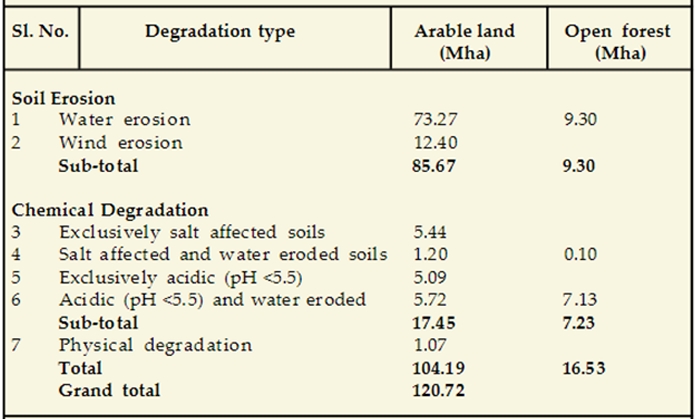
Source: https://icar.org.in/files/Degraded-and-Wastelands.pdf
The Indian Council of Agricultural Research and National Academy of Agricultural Sciences in 2010 published a detailed data set on soil erosion and major factors affecting soil health. The data set reveals that nearly 86 mha of the arable land is deteriorating due to water and wind erosion. Further more than 17 mha of arable land is deteriorating due to chemical degradation. In total 120.72 mha of arable land and open forest is under soil erosion due to various factors[4].
Scientists associated with ICAR A.K. Patra, N.K. Lenka and A.K. Biswas in one of their research papers published in 2015 listed the following five major causes of soil health deterioration in India[5].
- Wide spread soil erosion: soil erosion is a major cause of deterioration of soil health. According to an estimate of ICAR in 2010, out of 143 mha of arable land 104 mha land is eroded.
- Imbalance nutrient use: Both in high and low fertilizer using regions, the imbalanced use of fertilizer is common. The N:P:K ratio is currently at 8.0:2.7:1 as compared to the ideal level of 4:2:1. This nutrient imbalance has aggravated over the decades from 7.9:0.9:1 in 1951-52.
- Change in land-man ratio: Due to intensification in agriculture the food production in India has increased by five times. This has happened due to fertilizers, high yielding cultivars, pesticides and irrigation. This has immensely increased the pressure on agriculture land leading to deterioration of soil health.
- Nutrient Mining: The cultivation of crops leads to extraction of soil nutrients. The replenishment of the harvested nutrient is necessary for the maintenance of soil fertility. Nutrient mining is referred to as an imbalance between removed nutrients during crop cultivation and quantity of nutrient added to the field. The nutrient mining is also responsible for high imbalance of NPK in India.
- Reduced use of organics: organic fertilizers such as compost are important for maintenance of soil nutrients. However, Indian agriculture has increasingly relied upon chemical fertilizer over time.
Agriculture contributes around 17-18 percent to national GDP and more than 58% of India’s population is dependent on agriculture and allied occupation. To feed healthy food to all and ensure economic security for more than 58% of the population of India, soil health is important. A group of scientists published a paper in July 2022 in Science Direct reveals that more than 70% of soil in India suffers either from acidity or alkalinity[6]. The continuous deterioration of soil health in India leading to deficiency in plant nutrients and large scale malnutrition in the country.
Soil Health Management:
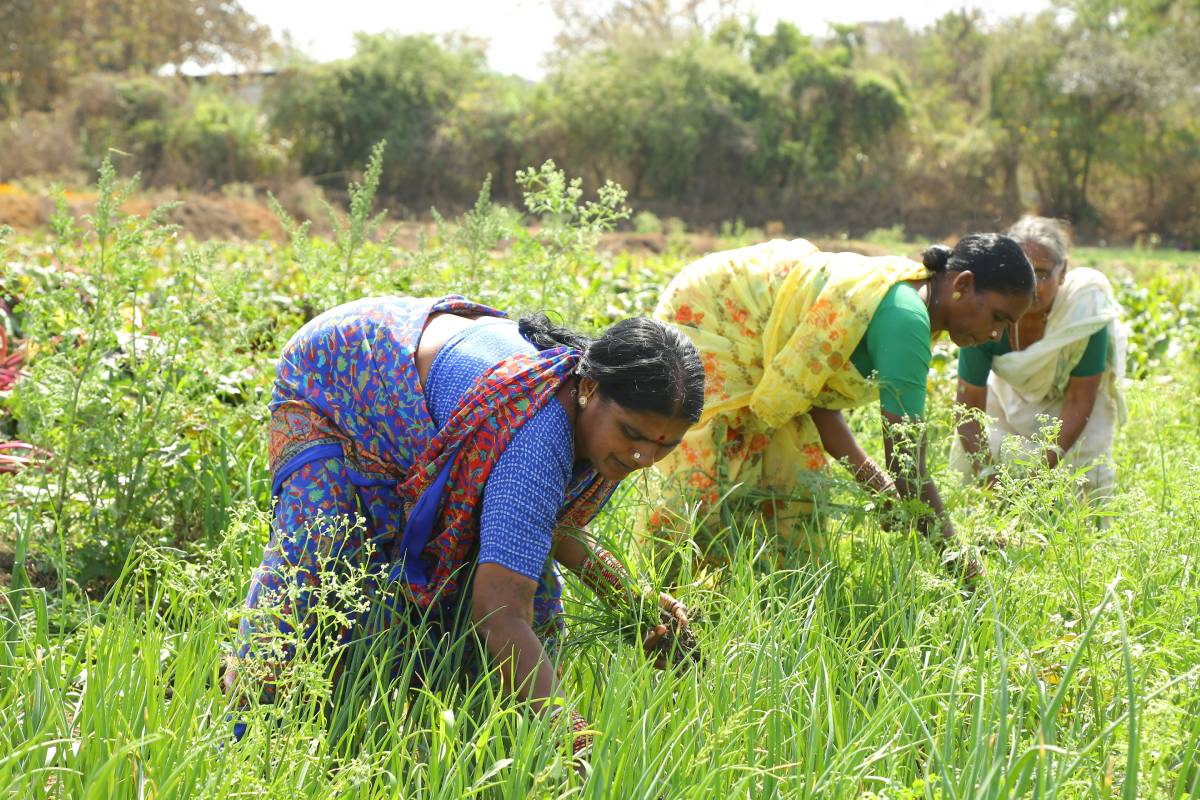
The soil health is directly connected with the plant and animal health. It further affects human health. All these together contribute to the environmental health and health of the planet. The United Nations Convention to Combat Desertification (UNCCD) recognizes these interrelationships originated from soils and recommends three broad principles to manage soil health. According to the UNCCD the first principle of the sustainable management of soil is protection of the natural ecosystem. This principle provides for restoring the pristine state of natural wealth. The second principle is to manage land that is under cultivation through sustainable agricultural practices. The third principle suggested by UNCCD is to restore land that is already deteriorated through right incentives to farmers, new technology and tools.
The UNCCD further suggest 10 point soil health management guidelines as follows[7]:
1- Minimize soil erosion
2- Enhance soil organic matter content
3- Foster soil nutrient balance and cycles
4- Prevent, minimize and mitigate soil salinization and alkalinisation
5- Prevent and minimize soil contamination
6- Prevent and minimize soil acidification
7- Preserve and enhance soil biodiversity
8- Minimize soil sealing
9- Prevent and minimize soil compaction
10- Improve soil water management
The UNCCD further argues that these strategies can be modified and improved based on local conditions and requirements. A group of three scientists of ICAR namely A.K. Patra, N.K. Lenka and A.K. Biswas in their paper published by Indian Journal of Fertilizer in 2015 suggested a fivefold approach to manage soil health in India. These approaches are as follows[8]:
- Soil health assessment– soil health assessment is to detect soil productivity through measurement of key physical, chemical and biological properties of soil.
- Containing nutrient mining– The balanced NPK ratio is important to harvest crops high in nutrients. To ensure availability of NPK in the field for next harvest must be met through organic and non-organic manure. Adequate amounts of manure/fertilizer will help in containing nutrient mining.
- Balanced fertilization and increasing fertilizer use efficiency– Access use of chemical fertilizer has adversely affected soil health across the country. Therefore mechanisms need to be developed to balance fertilization and ensure fertilizer efficiency.
- Maintaining soil physical structure- physical structure of soil can be improved by organics and crop residue. Such in-situ practices need to be conserved and promoted.
- Reducing soil erosion loss– In-situ techniques of keeping soil physical structure and methods of soil reclamation may be promoted and incentivized.
Reclamation of Problem Soils Scheme:
About 50% irrigated land in arid and semi-arid regions has some degree of soil salinization problem. The access accumulation of salt/acid is known as problem soil (alkali, saline, acid). According to the ICAR estimate there is 24.36 million hectare of problem soil across the county. For the reclamation of the problem soil the government of India has launched the ‘Reclamation of Problem Soils’ as a sub scheme under the Rashtriya Krishi Vikas Yojana. This scheme adopts following strategies to reclaim the problem soil[9]:
Reclamation and development of alkali, saline & acid soils in contiguous manner:
Implementation of various need based land improvement interventions like, peripheral/marginal bunds, check bunds, hydraulic sluice gate, surface and subsurface drainage systems, farm ponds/water harvesting structures, on farm development, prevention of water logging by construction of bioengineering measures for prevention of ingress of sea water;
Application of soil amendments, leaching of salt by allowing water impounding with conserved rain water and ensuring sustainability of reclaimed areas by continuous cultivation of recommended salt tolerant crop varieties;
Capacity building of farmers for continuous cultivation of salt tolerant crops/horticultural crops along with soil test based judicious application of fertilizers and micro nutrients to prevent reoccurrence of such problem soils; and
Adoption of a definite withdrawal strategy for maintenance of the drainage network & other assets created to ensure the production system is sustainable.
The Reclamation of Problem Soils scheme was started in financial year 2016-17 and as of financial year 2020-21 an amount of Rs. 58.76 crore (share of union government) was released to state governments. In this period about 0.24 lakh hectare agricultural land has been developed. Moreover bio-engineering soil and water conservation measures, watershed management interventions, soil reclamation measures for saline, alkali, waterlogged and acid soils, selection of suitable crop and such other activities have been carried out under the scheme[10].
Conclusion:
The process of soil formation is long and complex but once it is formed the physical, chemical and organic processes within soils creates a more complex ecosystem. A living soil is the soil which has maintained all these processes. Living soil is thus the foundation of life on the earth. The living soil provides almost all our food calories, regulates water supplies, supports biodiversity and helps in stabilizing the global climate[11]. Despite its huge importance like water, the soils remain a neglected resource.
The latest data released by the Space Application Centre in 2021 reveals that more than 29% of the total geographical area is facing serious problems of land degradation and desertification. There are a number of ways by which soil health is deteriorating. Soil erosion is a major factor that affects the health of the soil. Factors such as water, wind, overgrazing and poor agricultural practices lead to the erosion of soil[12]. Soil deterioration is also caused by excessive use of chemical fertilizers/pesticides, mono-cropping, acid rain and water pollution.
The first policy attempt to manage soil health was made in 1920 by the British administration through launching ‘Soil and Moisture Conservation Programes’. After independence various five-year plans stressed on the importance of combating soil erosion and land degradation[13]. In the decade of nineties the government of India launched the ‘National Watershed Development Project for Rainfed Areas (NWDPRA)’ project to combat soil erosion through watershed development approach. Moreover, in 2006 onward watershed management activities were integrated with MGNREGA.
While there have been some attempts at the level of public policy to conserve soils and combat degradation and desertification of land, yet more attention is required to maintain soil health. India’s Prime Minister Mr. Narendra Modi in his speech in COP 14 of UNCCD in 2019 committed that India will restore 26 million hectare degraded land from 2019 to 2030[14]. To achieve this ambitious goal, India has to accelerate its speed and enhance the scale of activities related to management of soil health.
References:
[1] https://www.navdanya.org/living-soil/what-is-soil
[2] https://www.mdpi.com/2077-0472/3/3/443
[3] https://www.researchgate.net/publication/289538576_Soil_Health_Assessment_and_Management_Issues_and_Strategies
[4] https://icar.org.in/files/Degraded-and-Wastelands.pdf
[5] https://www.researchgate.net/publication/289538576_Soil_Health_Assessment_and_Management_Issues_and_Strategies
[6] https://www.sciencedirect.com/science/article/pii/S2667006222000375
[7] https://www.unccd.int/sites/default/files/2022-10/AG2_Soil%20Health_final%20for%20web.pdf
[8] https://www.researchgate.net/publication/289538576_Soil_Health_Assessment_and_Management_Issues_and_Strategies
[9] https://agricoop.nic.in/sites/default/files/rps_guidelines%20%282%29.pdf
[10] https://pib.gov.in/PressReleasePage.aspx?PRID=1810912
[11] https://www.unccd.int/sites/default/files/2022-10/AG2_Soil%20Health_final%20for%20web.pdf
[12] http://clubofrome.in/downloads/Booklet_on_Forests_Land_and_Soils_for_All_CoR.pdf
[13] https://india.mongabay.com/2022/06/commentary-100-years-of-saving-indias-soil-what-needs-to-change/

